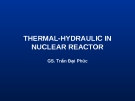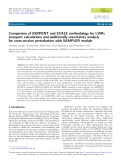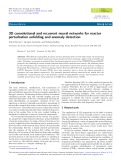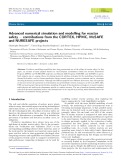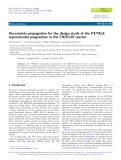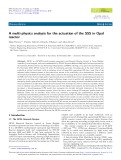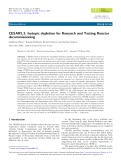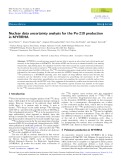
Nuclear reactors operating
-
I. Introduction An important aspect of nuclear reactor core analysis involves the determination of the optimal coolant flow distribution and pressure drop across the reactor core. On the one hand, higher coolant flow rates will lead to better heat transfer coefficients and higher Critical Heat Flux (CHF) limits. On the other hand, higher flows rates will also in large pressure drops across the reactor core, hence larger required pumping powers and larger dynamic loads on the core components.
 259p
259p  giotletinh_hd2009
giotletinh_hd2009
 20-04-2013
20-04-2013
 93
93
 19
19
 Download
Download
-
In nuclear safety research, the quality of the results of simulation codes is widely determined by the reactor design and safe operation, and the description of neutron transport in the reactor core is a feature of particular importance.
 14p
14p  christabelhuynh
christabelhuynh
 30-05-2020
30-05-2020
 42
42
 1
1
 Download
Download
-
With Europe’s ageing fleet of nuclear reactors operating closer to their safety limits, the monitoring of such reactors through complex models has become of great interest to maintain a high level of availability and safety.
 9p
9p  christabelhuynh
christabelhuynh
 29-05-2020
29-05-2020
 13
13
 1
1
 Download
Download
-
The goal of the simulation strategies is to model complex multi-physics and multi-scale phenomena specific to nuclear reactors. The use of machine learning combined with such advanced simulation tools is also demonstrated to be capable of providing useful information for the detection of anomalies during operation.
 14p
14p  christabelhuynh
christabelhuynh
 29-05-2020
29-05-2020
 10
10
 3
3
 Download
Download
-
The PETALE experimental programme in the CROCUS reactor intends to provide integral measurements to constrain stainless steel nuclear data. This article presents the tools and the methodology developed to design and optimize the experiments, and its operating principle.
 8p
8p  christabelhuynh
christabelhuynh
 29-05-2020
29-05-2020
 9
9
 2
2
 Download
Download
-
OPAL is a 20 MWth multi-purpose open-pool type Research Reactor located at Lucas Heights, Australia. It was designed, built and commissioned by INVAP between 2000 and 2006 and it has been operated by the Australia Nuclear Science and Technology Organization (ANSTO) showing a very good overall performance.
 8p
8p  christabelhuynh
christabelhuynh
 29-05-2020
29-05-2020
 5
5
 2
2
 Download
Download
-
The aim of this paper is to describe how CESAR operates and how it can be used to help these facilities care for waste disposal, nuclear materials transport or basic safety cases. The test case will be based on the PHEBUS Facility located at CEA Cadarache.
 10p
10p  christabelhuynh
christabelhuynh
 29-05-2020
29-05-2020
 11
11
 2
2
 Download
Download
-
MYRRHA is a multi-purpose research reactor able to operate in sub-critical and critical modes and currently in the design phase at SCK•CEN. The choice of LBE was driven by its chemical stability, low melting temperature, high boiling point, low chemical reactivity with water and air and a good neutronic performance.
 9p
9p  christabelhuynh
christabelhuynh
 29-05-2020
29-05-2020
 19
19
 1
1
 Download
Download








